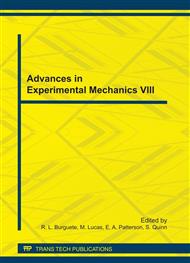p.105
p.111
p.117
p.123
p.129
p.135
p.141
p.147
p.153
Validation of Welding Simulations Using Thermal Strains Measured with DIC
Abstract:
Residual stresses can affect the performance of steel tubes in many ways and as a result their magnitude and distribution is of particular interest to many applications. Residual stresses in cold-rolled steel tubes mainly originate from the rolling of a flat plate into a circular cross section (involving plastic deformations) and the weld bead that closes the cross section (involving non-uniform heating and cooling). Focus in this contribution is on the longitudinal weld bead that closes the cross section. To reveal the residual stresses in the tubes under consideration, a finite element analysis (FEA) of the welding step in the production process is made. The FEA of the welding process is validated with the temperature evolution of the thermal simulation and the strain evolution for the mechanical part of the analysis. Several methods for measuring the strain evolution are available and in this contribution it is investigated if the Digital Image Correlation (DIC) technique can record the strain evolution during welding. It is shown that the strain evolution obtained with DIC is in agreement with that found by electrical resistance strain gauges. The results of these experimental measuring methods are compared with numerical results from a FEA of the welding process.
Info:
Periodical:
Pages:
129-134
Citation:
Online since:
August 2011
Keywords:
Price:
Сopyright:
© 2011 Trans Tech Publications Ltd. All Rights Reserved
Share:
Citation:


